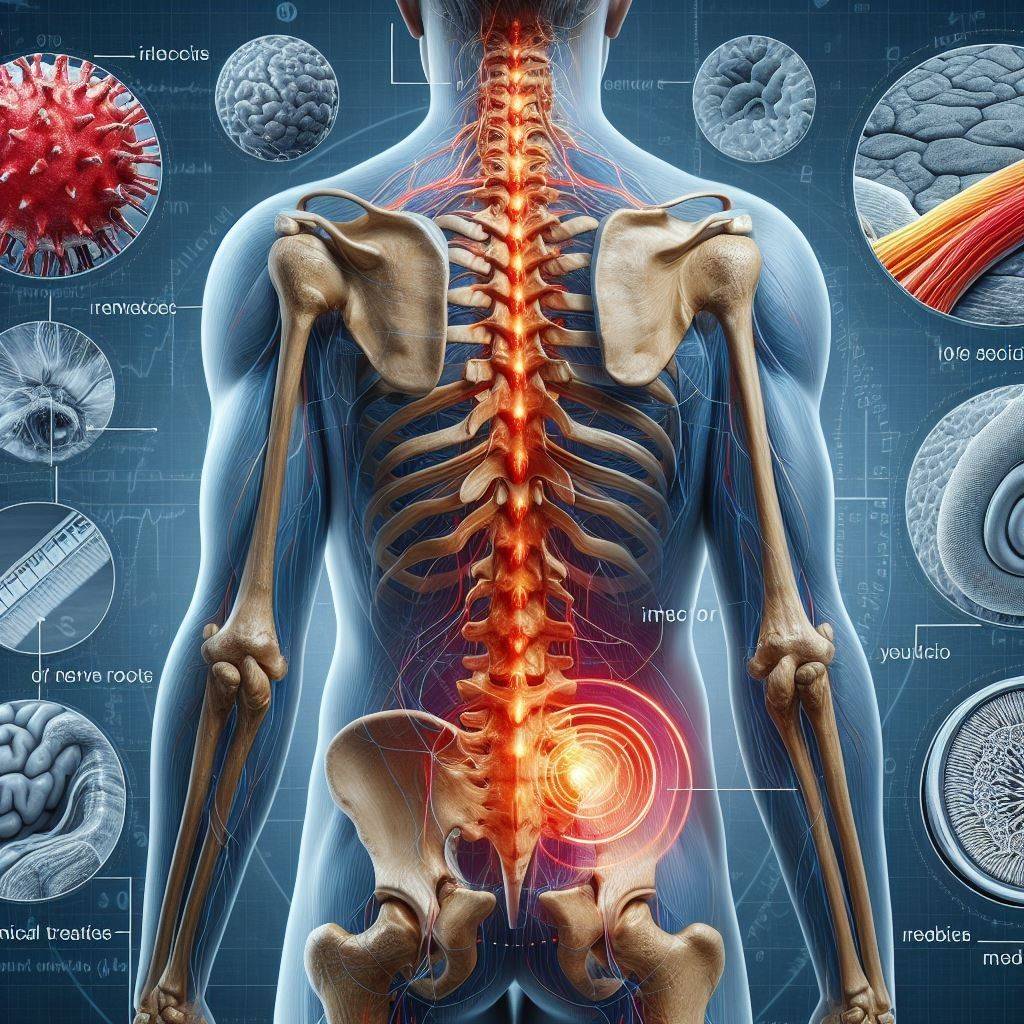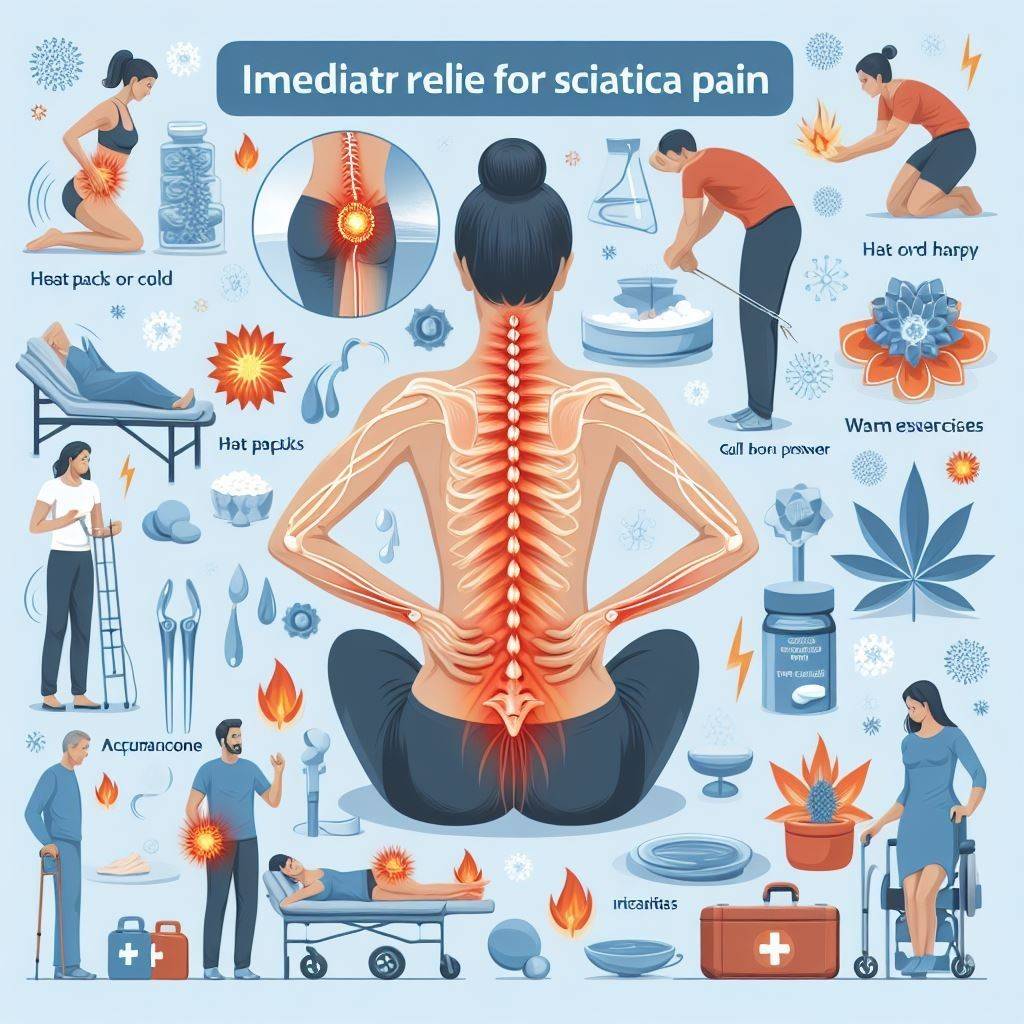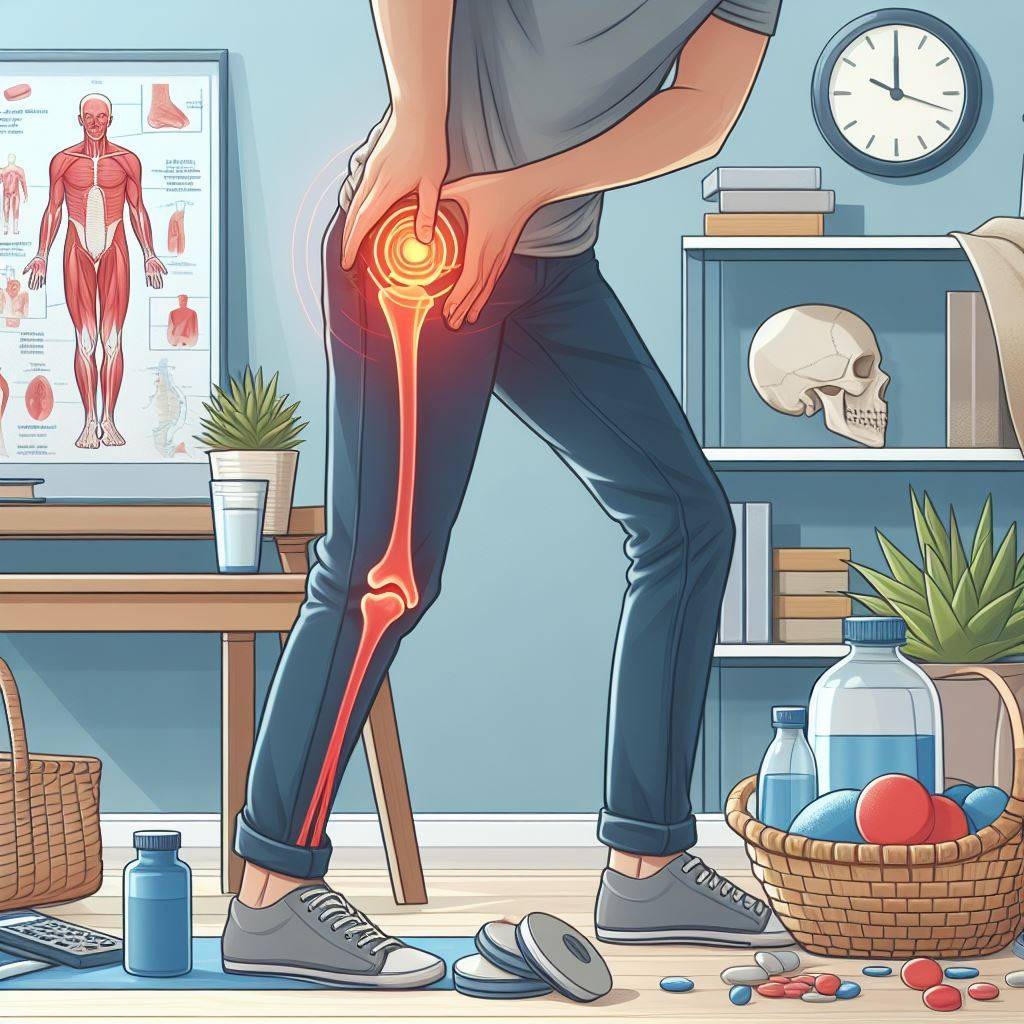Unlock Comfort Now: 13 Quick Fixes for Immediate Sciatica Pain Relief
Experience swift comfort with our blog on immediate relief for sciatica pain. Discover 13 quick fixes that work for instant soothing solutions.
Key Takeaways on Achieving Immediate Relief for Sciatica Pain
- Ice packs and heat therapy ease inflammation and numb pain
- OTC medications like NSAIDs, muscle relaxers, and topical gels offer quick alleviation.
- TENS, stretches, yoga poses, and massage provide fast sciatica relief.
- Mindfulness and finding comfortable positions also quickly lessen pain.
- See a doctor if severe symptoms last over a week or worse.
- Seek emergency care for loss of bowel/bladder control or leg weakness.
Introduction
When sciatica flares up, the nerve pain can be excruciating. You want solutions that offer immediate relief for sciatica pain – and you need them now. This article explores 13 techniques that may briefly alleviate your sciatica symptoms when they act up.
Sciatica refers to shooting pain that radiates along the path of the sciatic nerve, which branches from the lower back down through the hips and buttocks, and into each leg. It is often caused by a herniated (slipped) disc or bone spur compressing part of the nerve.
While sciatica sometimes resolves on its own over time, the pain can be intense and debilitating in the meantime. When an acute flare strikes, you don’t want to wait weeks or months for relief. Try these 13 quick fixes that may provide instant – or at least rapid – relief for sciatica pain.
Overview of Immediate Relief for Sciatica Pain

When sciatica rears its ugly head, here are some fast-acting methods you can try at home to calm the nerve and ease discomfort:
- Ice packs or cold therapy
- Heat packs, warm bath or shower
- Stretching or gentle exercises
- Massage therapy techniques
- Over-the-counter oral pain relievers
- Topical pain relief gels or creams
- Pain support devices like cushions or braces
- Sciatica-friendly yoga poses or stretches
- TENS (transcutaneous electrical nerve stimulation) therapy
- Acupuncture or acupressure
- Mindfulness, meditation, and relaxation
- Good pain relief habits and home remedies
- Finding a comfortable position
Keep reading for more details on how these quick fixes can provide immediate relief for sciatica pain.
13 Fast and Immediate Relief for Sciatica Pain

Here is an in-depth look at techniques, medications, devices, and other rapid solutions for Immediate Relief for Sciatica Pain:
-
Ice Packs
Applying an ice or cold pack to the painful area can numb sciatic nerve sensations and reduce inflammation. Wrap ice in a thin towel and apply to the lower back or back of the leg for 15-20 minutes several times per day during flare-ups.
-
Heat Therapy
Heat promotes blood flow and relaxes tightened muscles that may be irritating the sciatic nerve. Try a heat wrap, warm bath, or hot water bottle for 20 minutes. Avoid direct heat on numb skin.
-
OTC Oral Pain Relievers
Over-the-counter non-steroidal anti-inflammatory drugs like ibuprofen, naproxen, or aspirin can temporarily alleviate sciatic pain. Acetaminophen and muscle relaxers may also provide quick relief.
-
Topical Pain Relief Gel
Look for gels containing ingredients like menthol, camphor, lidocaine, capsaicin, arnica, turmeric, or CBD. Apply to the site of sciatic pain for fast-acting relief. Re-apply as the numbing effect wears off.
-
TENS Unit
TENS (transcutaneous electrical nerve stimulation) units deliver small electrical impulses through electrodes placed on the skin along the sciatic nerve pathway. This stimulation blocks pain signals, providing temporary relief.
-
Sciatica Exercises and Stretches
Simple stretches that gently bend, extend, and rotate the spine can offer relief by taking pressure off the compressed nerve. Try knee-to-chest, lumbar twists, figure four stretches, and other gentle moves.
-
Massage Techniques
Have someone gently massage the piriformis muscle and up along the sciatic nerve course. Or use a tennis ball or massage cane yourself against tight areas. This may release muscle knots.
-
Sciatica-Friendly Yoga Poses
Certain supported reclining or inverted yoga poses can take pressure off the lower spine and sciatic nerve. The child’s pose, legs up-the-wall, gentle spinal twists, and supported bridge pose offer quick relief for some.
-
Find a Comfortable Position
Lying on your side in the fetal position with a pillow between the knees, or sitting leaned forward supported by pillows might quickly feel better. Experiment to find a sweet spot.
-
Acupuncture and Acupressure
Seeking rapid relief from a trained acupuncturist can provide pain relief within one session by targeting trigger points. Acupressure using your fingers on points along the legs helps some people as well.
-
Meditation and Mindfulness
Meditation and breathing exercises shift focus away from the pain. Mindfulness-based stress reduction may modulate pain perception for temporary relief during flare-ups.
-
Good Sciatica Habits
Practicing good posture, lifting properly, and doing sciatica exercises regularly, can prevent flare-ups. But also provide more lasting pain reduction.
-
Additional Home Remedies
Some other natural temporary relief solutions include ginger supplements, turmeric tea, Epsom salt soaks, essential oil tropicals like wintergreen or eucalyptus, and staying active with gentle walking.
When to See a Doctor about Sciatica Relief
While the techniques above may offer fast alleviation of flare-up pain, be sure to see a doctor if:
- Pain persists longer than 1 week without improvement
- You experience muscle weakness or numbness
- Pain severely limits normal activity
- You have difficulty controlling bowel or bladder
- You have a fever, chills, or unexplained weight loss
- Non-prescription pain relief stops helping
Unlock immediate relief for sciatica pain with these 13 quick fixes. Seek emergency care for severe symptoms. While home remedies offer temporary relief, always consult a medical professional for persistent or worsening sciatica.
Developing Your Sciatica Relief Toolbox
Having a toolbox prepared with different solutions that offer rapid relief for sciatica pain helps you manage flare-ups at home. Here are some of the key items to include:
- Cold packs – ice packs or reusable cold therapy wraps
- Heating pads – electric or microwavable packs
- OTC meds – ibuprofen, acetaminophen, lidocaine patches
- Topical gels – menthol, capsaicin, CBD, turmeric creams
- Back braces, seat cushions, or lumbar support pillows
- Self-massage devices – tennis balls, massage sticks, foam rollers
- Yoga strap, yoga bolster, and yoga wheel for certain poses
- TENS unit with electrode pads
- Meditation apps, headphones, yoga mat
Unlock immediate relief for sciatica pain with these 13 quick fixes. Keep these sciatica relief aids handy at home, in your car, and at work. Immediate Relief for Sciatica Pain Having quick access to a variety of solutions lets you find what works best to ease your particular pain. Rotate different techniques for long-lasting relief.
When to Use Ice vs Heat for Sciatica
Both ice and heat offer quick relief benefits, but when should you choose cold vs warm therapies? Here are some general guidelines:
Use Ice for:
- Severe or sudden pain – to reduce inflammation
- Numbness/tingling – cold can dull sensation
- Swelling around the nerve
- First 48-72 hours of flare-up
Use Heat for:
- Dull, achy, or muscular pain
- Tightness and painful muscle spasms
- Stiffness and reduced mobility
- After the first few days of acute inflammation,
Try alternating brief sessions of cold followed by heat therapy for optimal relief. But avoid direct ice or heat application over areas of numb skin. See what temperature works best to reduce your particular sciatic pain.
Lifestyle Adjustments for Preventing and Treating Sciatica

- Exercises – Daily core and spine stabilizing exercises to support the back. Also, regular hamstring stretches.
- Ergonomics – Use lumbar support pillows for chairs. Adjust the seat height, computer monitor, etc.
- Body Mechanics – Practice proper lifting, bending, and posture to avoid spine irritation.
- Stress Relief – Chronic tension aggravates pain, so make time for relaxing activities.
- Diet – Anti-inflammatory foods like fatty fish, turmeric, ginger, greens, cherries, and avoiding inflammatory triggers.
- Weight Control – Excess weight overloads the spine, so maintain a healthy BMI.
- Firm Mattress – Use a medium-firm mattress to support the lower back while sleeping.
- No Smoking – Smoking impedes spinal disc healing.
- Physical Therapy – Work with a PT to strengthen the core and improve mobility.
Making lifestyle adjustments to prevent sciatica flare-ups, along with using quick home remedies during acute episodes, offers lasting relief. But always see your doctor if symptoms persist or worsen. Consistent treatment helps resolve the underlying cause of sciatic nerve pain.
FAQs about Immediate Relief for Sciatica Pain
What relaxes the sciatic nerve?
Applying a heating pad or warm compress to the lower back and down the back of the leg can help relax muscles and reduce spasms that may be irritating the sciatic nerve. Gentle stretches like knee to chest and figure four stretches also take pressure off the nerve. Massage and acupuncture can relax the surrounding tissues. Finding a comfortable resting position, meditation, and stress management help many people relax during sciatica flares.
What is the best painkiller for sciatica?
Over-the-counter non-steroidal anti-inflammatory drugs like ibuprofen or naproxen are often effective for temporary sciatica pain relief. Muscle relaxers can also calm muscle spasms aggravating sciatica. Some people get good pain relief from topical creams containing menthol, capsaicin, turmeric, or CBD applied to the painful areas. Prescription medications like gabapentin or cortisone injections might be options if OTC drugs don’t adequately control sciatica pain.
What is the fastest way to cure sciatica?
While there is no instant cure, applying heating pads, stretching, and taking anti-inflammatory medications can provide the fastest relief when sciatica flares up. Getting rest, avoiding aggravating activities, and using good posture and ergonomics also help speed healing. In severe cases, steroid injections, or surgery might be the quickest way to get lasting pain relief. With mild sciatica, home remedies typically work within a few weeks. See a doctor if you don’t get relief within 1-2 weeks.
What are 2 symptoms of sciatica?
Two hallmark symptoms of sciatica are: 1) pain that radiates from the lower back down the back of the leg, and 2) tingling, weakness or numbness along the sciatic nerve pathway. Other common symptoms are difficulty sitting or standing for long periods, sharp burning, or aching pain, and pain triggered by coughing or sneezing. The pain is usually only on one side. See a doctor if you have leg weakness or pain lasting over a week.
Conclusion about Immediate Relief for Sciatica Pain
Dealing with intermittent sciatica flare-ups can feel like a frustrating rollercoaster ride. When pain strikes, homing remedies and quick fixes for instant relief help you cope in the short term. But making lifestyle changes then provides more lasting prevention between backslide episodes.
Patience is key, as sciatica often improves gradually over weeks or months with rest, OTC meds, exercises, ergonomic adjustments, and other non-invasive techniques. Avoid aggravating activities during flare-ups that may re-injure the compressed nerve.
With consistent treatment, most cases of sciatica resolve fully. Home remedies offer immediate relief when you need it, while healthy lifestyle adjustments help smooth out the ups and downs. Stay the course and keep.



